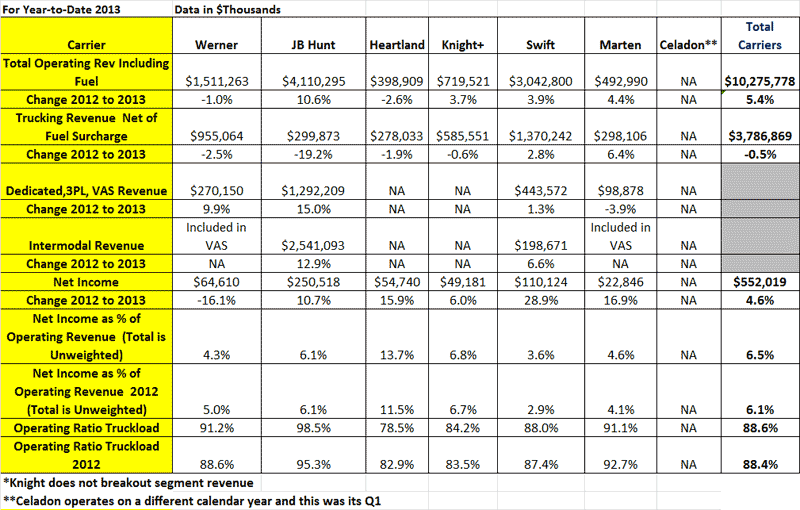Year to date results for 2013, as shown in the table below, are largely along the same lines. Pure trucking revenue remains very flat for the group, while most see a lot more growth from intermodal and other value-added services.
US Truckload Results Year-to-Date 2013

See Full Size Image
Operating ratios in trucking are about flat this year versus 2012. As usual, Heartland leads the way so far in 2013, with an OR of just 78.8%. Outside JB Hunt, which almost appears to be exiting straight truckload carriage business, the highest operating ratios for the year-to-date have been turned in by Werner and Marten, at just over 91%.
As usual, we also share some of the more noteworthy management comments from the carriers from their Q3 earnings releases.
Werner
Said Q3 demand was up modestly over 2012, citing slightly tighter capacity due to the implementation of the new HOS changes and slightly improved overall freight volumes.
Average revenues per total mile, net of fuel surcharge, rose 2.4%, implying rate increases of somewhere near the same.
Company slightly increased its truck count to 7245 in the quarter, an increase of 45 tractors, but that was largely to meet the heavier Q3 seasonal demand, as Werner like most others is committed to asset discipline.
Noted that "It is very difficult for many smaller and medium size private carriers to replace their older, lower-value trucks with much higher cost, EPA-compliant new trucks, which significantly reduces the risk of trucks being added to the market," as would happen if these carriers acquired new trucks and sold the older ones off to other small carriers.
JB Hunt
The transformation away from straight truckload carriage continues. In Q3, its truckload business
contributed just 7% of total company revenue, and just 1% of profits. The number of trucks in the segment was down to 1,951 tractors compared to 2,381 a year ago.
Meanwhile, Hunt's intermodal segment continues to power ahead. Overall volumes increased 11.6% over the same period in 2012. Eastern network growth was 14.0% and transcontinental growth was 10.2%
Heartland
Noted that decent improvements in rates "were more than offset by new government regulations on hours of service, a competitive environment for the high quality, professional truck drivers who meet our hiring requirements, an inconsistent freight environment, and slightly lower fuel surcharge revenue."
Continued investment in replacing its tractors has driven average age of the Heartland's fleet to just 2.0 years as of September 30, compared to 2.4 years as of September 30, 2012.
Knight
Company said running it ran 3.6% fewer tractors than last year in Q3, yet was able to grow revenue on a year over year basis.
Revenue in its traditional "asset-based" business was up 2.7%, while growth in its non-asset based segment (brokerage, logistics services, etc.) was up 29.3%. However, those latter businesses are not very profitable yet.
We will also note Knight that is continuing to press the campaign it launched in late August to take over USA Truck by buying up outstanding shares of the Van Buren, AR-based provider of truckload and dedicated freight services.
USA Truck has characterized Knight's overture as a "creeping hostile acquisition." But USAT has not yet ruled out a deal, even though it spurned the most recent offer as being "inadequate, as it substantially undervalued" the company.
Just two years ago, USA Truck rejected a proposal for merger talks with Celadon. USA Truck has a highly complementary service area to Knight's current network.
Marten
Company reported the highest net income for any quarter in the company's history, 22.4% to $8.0 million. That makes it the
fourteenth consecutive year-over-year increase in quarterly profitability.
Year to date, net income has increased 16.9% to $22.8 million
Total truckload, intermodal and broker loads combined increased 11.9% in the third quarter of 2013 over 2012.
Swift
Company e acquired Central Refrigerated Transportation, a company owned by CEO Jerry Moyes. Revenue at the unit was up 15% in Q3.
Said the industry is "facing less than ideal market conditions," adding that " Our industry is experiencing substantial headwinds including higher equipment and maintenance costs, an increasingly constrained driver market, challenging new hours of service regulations, and a lackluster freight environment."
Said a 1.2% decrease in loaded miles per tractor per week was due primarily to the new hours of service rules.
Celadon
Was one of the few carriers to significantly increase it average seated tractor count, which rose by 288, or 10.5%, to 3,024 in Q3 compared with 2,736 in 2012. This was primarily the result of two acquisitions, however. That means that while Celadon increased its tractor count, not many if any true new trucks were added to overall industry capacity.
Said it "believes truck capacity will continue to tighten for the truckload industry.
The average age of the company's tractor fleet was a very low 1.4 years at the end of Q3, versus 2.4 years in 2012.
Any reaction to the truckload Q3 and YTD 2013 results? Let us know your thoughts at the Feedback button (for email) or section (for web form) below.

|